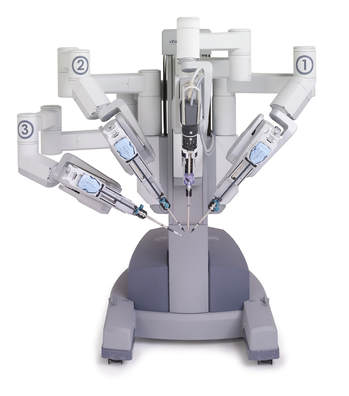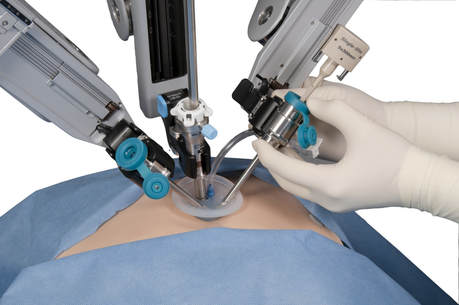|
Dr. Kader is a minimally invasive surgery expert, performed over 500 robotic gynecologic cases. He is performing the most complex robotic surgeries on regular basis.
What is Robotic Surgery and How is it performed?
Robotic surgery is a specific type of minimally invasive laparoscopic approach utilizing the da Vinci Surgical system robot, which the surgeon controls from a separate console. The Robotic da Vinci system allows the surgeon to operate through a few small incisions using a magnified 3D HD vision system and instruments that bend and rotate for enhanced vision, precision, access and control. The dexterity of the Robotic instruments allows the surgeon better access, better visualization and near human movements. Those advantages overcome many limitations regular laparoscopic surgery or even open surgery has. In well trained hands, Robotic surgery may allow complex surgeries to be performed through small incisions with minimal blood loss and easier and faster recovery. It may as well reduce many intraoperative and postoperative risks associated with hysterectomy and paves the way for easier and quicker recovery. Conditions treated? The Robotic approach is used to treat several common problems including:
Procedures performed? Dr. Kader performs these gynecologic surgeries using the Robotic system :
|
Conventional open incision vs Robotic incisions
|
When is Robotic gynecologic surgery most beneficial?
Robotic surgery is most beneficial when it is used as an alternative to open surgery, thus allowing the benefits of a minimally invasive surgery for cases that would otherwise mandate open surgery.
Examples of those conditions:
What are the advantages of robotic surgery compared to open surgery?
What to expect during recovery?
Dr. Kader mastered the use of the robot which allowed a minimally invasive approach to hundred of patients, many of which had previous surgeries or existing complicated medical conditions.
Using this approach, his patients enjoyed minimal blood loss, shorter hospital stay and faster, easier recovery compared to traditional laparoscopic or open surgeries.
What are the chances my case will be converted to an open surgery?
Over 5 years, Dr. Kader has not converted any Robotic surgery to an open surgery after confirming Robotic approach is suitable intraoperatively.
It is however always a possibility that, at the beginning of surgery, a Robotic approach would be deemed unsuitable.
In rare instances, an additional small incision for specimen extraction may be required.
Conversion to an open surgery is always reserved for use for a variety of circumstances to ensure patient’s safety.
(1)Betcher RE, Chaney JP, Lacy PR, Otey SK, Wood DJ. Analysis of postoperative pain in robotic versus traditional laparoscopic hysterectomy. J Robot Surg. 2014 Mar;8(1):35-41. doi: 10.1007/s11701-013-0418-z. Epub 2013 Jul 3.
(2)Varghese A, Doglioli M, Fader AN. Updates and Controversies of Robotic-Assisted Surgery in Gynecologic Surgery. Clin Obstet Gynecol. 2019;62(4):733-748.
(3) Pitter MC, Anderson P, Blissett A, Pemberton N. Robotic-assisted gynaecological surgery-establishing training criteria; minimizing operative time and blood loss. Int J Med Robot. 2008 Jun;4(2):114-20.
(4) Gupta N, Mohling S, Mckendrick R, Elkattah R, Holcombe J, Furr RS, Boren T, DePasquale S. Perioperative outcomes of robotic hysterectomy with mini-laparotomy versus open hysterectomy for uterus weighing more than 250 g. J Robot Surg. 2018 Dec;12(4):641-645.
(5) Lauterbach R, Matanes E, Lowenstein L. Review of Robotic Surgery in Gynecology-The Future Is Here. Rambam Maimonides Med J. 2017;8(2):e0019. Published 2017 Apr 28. doi:10.5041/RMMJ.10296
(6) Kalogera E, Glaser GE, Kumar A, Dowdy SC, Langstraat CL. Enhanced Recovery after Minimally Invasive Gynecologic Procedures with Bowel Surgery: A Systematic Review. J Minim Invasive Gynecol. 2019 Feb;26(2):288-298.
(7)Arms RG 3rd, Sun CC, Burzawa JK, Fleming ND, Nick AM, Rallapalli V, Westin SN, Meyer LA, Ramirez PT, Soliman PT. Improvement in quality of life after robotic surgery results in patient satisfaction. Gynecol Oncol. 2015 Sep;138(3):727-30.
Robotic surgery is most beneficial when it is used as an alternative to open surgery, thus allowing the benefits of a minimally invasive surgery for cases that would otherwise mandate open surgery.
Examples of those conditions:
- Large fibroids
- History of prior abdominal or pelvic surgeries
- Presence of endometriosis
- Additional medical or surgical conditions making an open surgery a higher risk, as long as the patient is still fit for a laparoscopic surgical procedure and still fit for open surgery if indicated.
What are the advantages of robotic surgery compared to open surgery?
- Less pain (1)
- Fewer complications (2)
- Less blood loss (3,4)
- Shorter hospital stay (4)
- Lower risk of wound infection (5)
- Quicker recovery and return to normal activities (6,7)
What to expect during recovery?
Dr. Kader mastered the use of the robot which allowed a minimally invasive approach to hundred of patients, many of which had previous surgeries or existing complicated medical conditions.
Using this approach, his patients enjoyed minimal blood loss, shorter hospital stay and faster, easier recovery compared to traditional laparoscopic or open surgeries.
What are the chances my case will be converted to an open surgery?
Over 5 years, Dr. Kader has not converted any Robotic surgery to an open surgery after confirming Robotic approach is suitable intraoperatively.
It is however always a possibility that, at the beginning of surgery, a Robotic approach would be deemed unsuitable.
In rare instances, an additional small incision for specimen extraction may be required.
Conversion to an open surgery is always reserved for use for a variety of circumstances to ensure patient’s safety.
(1)Betcher RE, Chaney JP, Lacy PR, Otey SK, Wood DJ. Analysis of postoperative pain in robotic versus traditional laparoscopic hysterectomy. J Robot Surg. 2014 Mar;8(1):35-41. doi: 10.1007/s11701-013-0418-z. Epub 2013 Jul 3.
(2)Varghese A, Doglioli M, Fader AN. Updates and Controversies of Robotic-Assisted Surgery in Gynecologic Surgery. Clin Obstet Gynecol. 2019;62(4):733-748.
(3) Pitter MC, Anderson P, Blissett A, Pemberton N. Robotic-assisted gynaecological surgery-establishing training criteria; minimizing operative time and blood loss. Int J Med Robot. 2008 Jun;4(2):114-20.
(4) Gupta N, Mohling S, Mckendrick R, Elkattah R, Holcombe J, Furr RS, Boren T, DePasquale S. Perioperative outcomes of robotic hysterectomy with mini-laparotomy versus open hysterectomy for uterus weighing more than 250 g. J Robot Surg. 2018 Dec;12(4):641-645.
(5) Lauterbach R, Matanes E, Lowenstein L. Review of Robotic Surgery in Gynecology-The Future Is Here. Rambam Maimonides Med J. 2017;8(2):e0019. Published 2017 Apr 28. doi:10.5041/RMMJ.10296
(6) Kalogera E, Glaser GE, Kumar A, Dowdy SC, Langstraat CL. Enhanced Recovery after Minimally Invasive Gynecologic Procedures with Bowel Surgery: A Systematic Review. J Minim Invasive Gynecol. 2019 Feb;26(2):288-298.
(7)Arms RG 3rd, Sun CC, Burzawa JK, Fleming ND, Nick AM, Rallapalli V, Westin SN, Meyer LA, Ramirez PT, Soliman PT. Improvement in quality of life after robotic surgery results in patient satisfaction. Gynecol Oncol. 2015 Sep;138(3):727-30.
SINGLE SITE ROBOTIC SURGERY
|
What is a single site Robotic Surgery?
The single site Robotic surgery is done through a small incision in your belly button. The da Vinci system allows your surgeon to operate through this small incision using a magnified 3D HD vision system and instruments that bend and rotate for enhanced vision, precision, access and control. Conditions treated? The Robotic approach is used to treat several common problems including uterine fibroids, ovarian cysts, abnominal uterine bleeding and more. |
What to expect during recovery?
Dr. Kader is one of very few surgeons performing single site Robotic surgeries. Using this technology on carefully selected candidates, patients can have a virtually scarless surgery to allow better cosmetic outcome. In addition, other benefits of robotic surgery apply.
Learn more about the da Vinci Robotic surgery
Dr. Kader is one of very few surgeons performing single site Robotic surgeries. Using this technology on carefully selected candidates, patients can have a virtually scarless surgery to allow better cosmetic outcome. In addition, other benefits of robotic surgery apply.
Learn more about the da Vinci Robotic surgery







